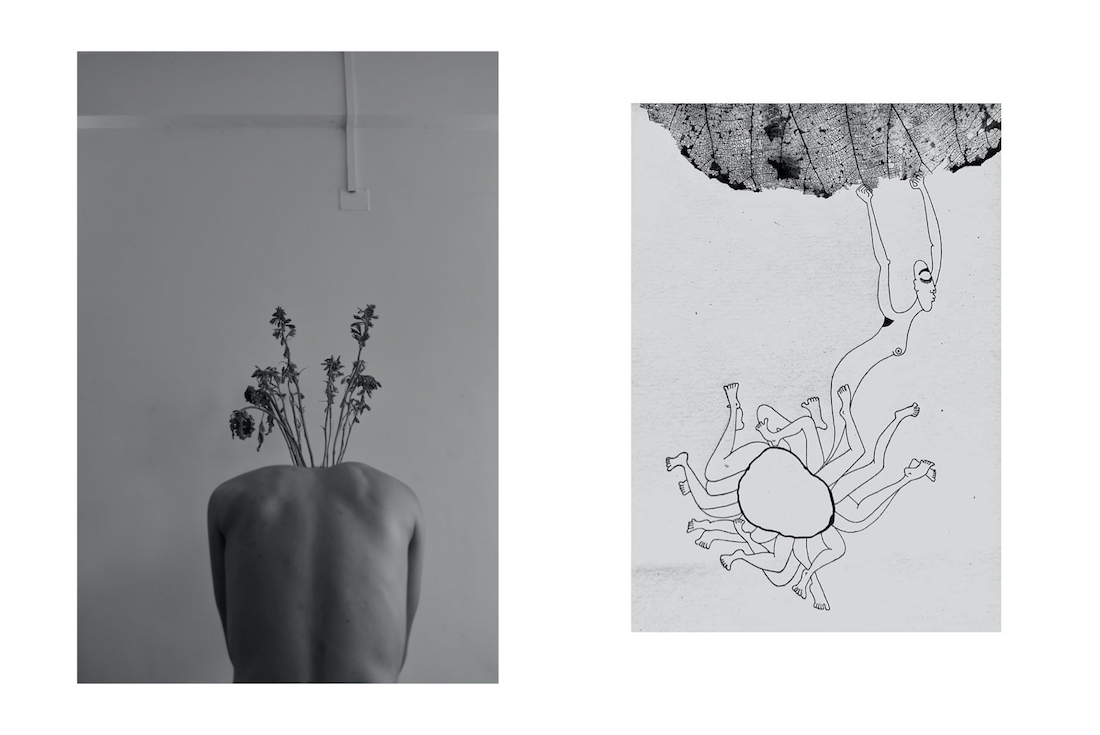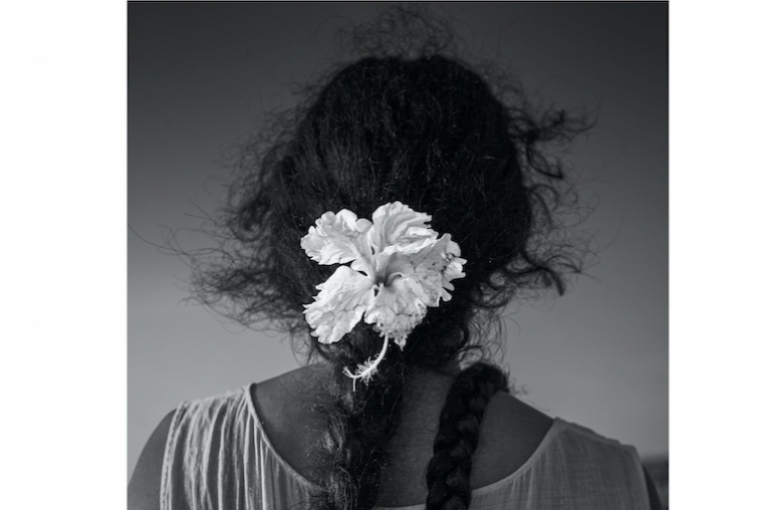
L: Home ; R: Non-Verbal Pathways

L: Home ; R: Non-Verbal Pathways
Artist and photographer Janhavi Sharma grew up surrounded by parents who practiced art themselves. Her mother was fluent in oil painting and her father continues to explore the mediums of ceramic and metal. So, it was only natural for Janhavi to familiarise herself with these skills early on in life. Eventually learnt how to express herself through the art she was creating. While she has never held an actual degree in the field, it is now, finally at the age of 27, that she is pursuing an MFA in Fine Arts from Nottingham Trent University. She may have deviated from her true calling initially but she has finally found her way back.
She explains, ‘I did take a very long detour to choose art as my career. I did my graduation in Mass Media, with a specialisation in Journalism from Mumbai University, and continued to pursue everything in the periphery after that — writing, theatre, film, photography. I think not having a formal education in the arts initially, really helped me in getting a socio-political understanding of things. Now I approach art making with my experience in all these different disciplines and media. About two years ago I got curious about learning Critical Art Theory, so I did a post graduate diploma in Modern and Contemporary Indian Art and Curatorial Studies from Bhau Daji Lad Museum. After that, my instinctive, primal tug towards creative expression was loud and clear enough for me to pursue Fine Arts as my primary profession. I’d already created a body of work by then, and even exhibited some of it. But, as is common knowledge, it’s not easy to sustain your art practice as an emerging artist. So I would end up spending more time of my day doing odd freelance jobs and not having any hours left to work on my practice. Just to be able to focus entirely on my artwork, I decided to study again.’
Janhavi’s creative narratives can take birth even in the most banal situations. She finds inspiration in daily conversations and observing peculiarities, like an individual’s body language. Being consciously aware of every minute detail in her surroundings, rituals like the combing of hair, cooking of food and other domestic chores may even find space in her art.‘Political climates are inspiring — the way stories are told, who tells it and how, what’s present and absent in the narrative. Understanding my own privilege, and the guilt that comes with it, rectifying it, and educating myself. I like to work with memory a lot, especially maternal histories. I think it’s very fascinating to explore how women remember other women in their homes. I love listening to the same stories again and again, noting what repeats, what gets highlighted, exaggerated and lost. I have also found that sometimes inspiration comes later, and the action of creating comes first. In the process of making itself, your muscle memory is triggered, your subconscious is active and something just materialises itself,’ she adds.
To tackle her creative block the artist reads, especially feminist literature. She further seeks out works of translation from parts of India and South Asia to gain perspective. Some of her favourites include Challapali Swaroopa Rani, Meena Kandasamy, Nabanita Kunungo, Bahina Bai and Ameena Hussein. Furthermore, one of Janhavi’s idiosyncratic qualities includes working on artworks that signify nothingness. At a time when the concept of productivity is romanticised in the mainstream, the artist recognises the highly political inclination behind it. She finds it conducive to document the long stretches of demotivation and absolute nothingness. She explains, ‘I believe not being productive at all is also okay, and in fact extremely crucial to being authentic about one’s work. To make sense of things, sense as in touch, feel, listen, visualise, one needs long pauses. I’m teaching myself to embrace those pauses more than I did before.’
Growing up in the small town of Jalgaon, near Aurangabad, the artist grew up surrounded by water bodies and vast stretches of moorlands covered in wild flowers during spring, with endless possibilities of finding the most colourful of moths and insects around. A recluse, she enjoyed spending time alone and around nature. Without consciously putting in effort, nature became an integral aspect of her being and her practice. Some of her oldest drawings are of Hoopoes, sunbirds, bee-eaters and wood-peckers that she would spot hustling around her mother’s garden. She would even go on to collect wild, fallen flowers and bring them home to recreate colour palettes. Her love for the environment has now translated to bringing issues close to it in the mainstream through her work.
She elucidates, ‘My primary research is getting more specific to Ecofeminism. The relationship between women and nature was apparent to me long before I was introduced to this term, and the more I read about it, the more convinced I am of its long-term impact on my practice. The obvious links between the imposed subordination of women and nature, the acceptance that much of climate crisis can be fought with simpler, local solutions suggested by women who have been nurturing these resources before greedy corporates got there, and the idea of decolonising nature from masculine capitalism, are a few of many aspects of this subject that invite me to dig deeper, and explore these ideas visually. I’m currently reading Ecofeminism by Maria Mies and Vandana Shiva, Women, Nature, Culture edited by Karen J Warren and Eco Sufficiency and Global Justice by Ariel Salleh that have been provoking my inquiry.’
Janhavi doesn’t have a set process she works with. Her novelty lies in discovering new ways of creating. Her work flows effortlessly between mediums. On most occasions, what she draws acts as a reference point for her photographs or her photographs are somehow distorted in what she paints. There have been instances when the materials she makes use of become the context. Her fascination with hair has found itself manifested through the motif of a braid, further investigating the tactile relationship between hair, its carers and nature. She breaks it down further, ‘The story would be entirely different if you paint hair, compared to using long extensions of hair in a photograph, or simply creating an installation that’s made of human hair itself. While painting offers more control, more scope for fallibility, the same story when shown as a photograph, becomes a part of a more tangible reality, and the installation would invite more participation and interaction. So my choice of media depends on the narrative itself.’
Further delving into her body of work, she adds, ‘I don’t believe I have finished anything I have made till now, because there’s always an intriguing possibility of what the thought might evoke if it's explored in another form or material. And that’s why I’m really grateful for this time I have here at my university, it’s widened my scope. I am asking questions like what would photography mean if I design the vessel in which it's presented, or if it's printed using an alternative technique, or if I can draw on the images after having printed them. I believe this process itself, the way one thinks about creating their work, this fragmented, half-erased, non-structured, inarticulate, untidy but indefatigable way of thinking is actually where the art lies. What it induces after it is made, is merely a consequence of that thought, not necessarily relevant.’

Extensions
If one were to ask Janhavi what it was she wanted her viewers to take away from her work she would simply say, ‘I don't know.’ As someone who attempts to disassociate from the perception of her, the artist strongly believes in plurality. For her, what the audience takes away is never the intention behind producing the work. She hopes people are able to assess and find more than one meaning. She also hopes her work never gets reduced to being merely beautiful and ‘that it evokes disgust, anger, lament, empathy, instability, distortion and more such negotiations with human complexity.’
With another lockdown in the U.K., the artist is now focused on producing work from home. She worked on a mixed media installation called Residue, using ingredients and spices she brought from India. Incorporating the colours of Indian cooking, the installation builds a dialogue around the politics of food, the ritual and intimacy of food making, the close associations of women and domesticity, and the history of it that got lost and replaced somewhere in the mass manufactured frozen food culture of today. Post her MFA she plans to take up the module to propose a doctoral research in the final year, hence, by the time Janhavi returns to India, she would have earned a phD as well.